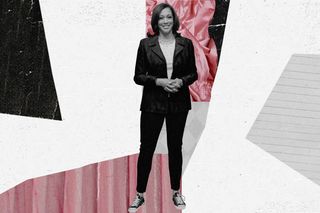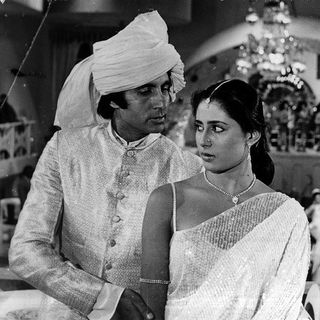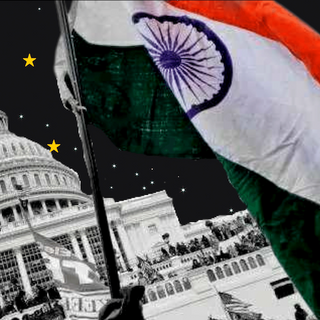
The Kamala Harris Vogue Cover Shows Fashion Magazines Are Struggling for Relevance
Readers want authenticity, but they also want powerful women to be treated with reverence.

Kamala Harris’ cover photo on Vogue magazine’s February issue puts you at ease around her. She poses in a blazer designed by her friend, Donald Deal, and in black-and-white Converse sneakers — hallmarks of her campaigning days. The pink satin background shows off the colors of her historically African-American sorority Alpha Kappa Alpha. Tyler Mitchell — the first black person to shoot a Vogue cover — photographed Harris. The first Black woman vice-president-elect of the United States of America looks warm, approachable, and even a bit goofy on the cover, in order to match the image she cultivated on the campaign trail.
Yet, the cover bombed — and how. From internet commenters to Pulitzer-winning fashion critics, the opinion was clear: the Vogue cover did not accord the vice-president-elect the respect she commands. Vogue, long a bastion of power and glamor — made a deliberate decision to take that power away from Harris. As Robin Givhan writes for the Washington Post, “It was a cover image that, in effect, called Harris by her first name without invitation.”
Here, Vogue did try to do everything right — but failed anyway. It didn’t intentionally create a poor cover for Harris, though Vogue’s terrible history with Black cultural figures led manypeople to make such an assertion. Neither is Vogue’s team incompetent — everything from the set design’s significance to the choice of photographer indicates a team effort that wanted to do right by Harris. The problem is the history of power showcased in fashion magazines — so rigid in its glamor, that the magazines cannot show a relaxed, people-friendly individual without inadvertently communicating a rejection of power.
Related on The Swaddle:
Why Are Women Judged for Their Fashion Sense?
The fashion magazine cover — Vogue’s especially, but also others — is a lot more than just a glamorous photo; it has always been a cultural marker for women in positions of power to display their acceptance into elite spaces and their public influence. This is why Donald Trump complained that his wife, Melania, was never photographed by Vogue as a First Lady during his tenure as president, while other first ladies, like Michelle Obama, received multiple Vogue covers. Fashion magazine covers like Vogue’s are almost a slice of history because their function is to depict the powerful and the glamorous at the height of their dignity.
But, traditional depictions of fashion, glamor, and power do not hold water with the magazines’ main target audience anymore. Women’s magazines are dying due to a growing shortage of print advertising funds. Plus, the vast majority of women readers are abandoning glossy catalogs for the snappy, socio-politically relevant coverage of the online feminist publication — offering up inside views into the lives of the famous and the powerful without putting them on a pedestal the way a fashion magazine would. As a last-ditch attempt to stay relevant, magazines required a rapid change in their content strategy — they needed to get more politically opinionated.
Women’s magazines do have a long history of covering important political conversations around women’s rights (Cosmopolitan was covering birth control in the 1960s), but their stances have always been neutral. But, in the 2010s, in order to survive, these magazines started to take strong stances on the issues that excited and enraged women. For example, Cosmopolitan covered Ivanka Trump’s policies on child care; Vogue officially endorsed Hillary Rodham Clinton for president, and Teen Vogue covered how Donald Trump was gaslighting the United States. Yet, their covers continued to remain a showcase of glamor, or glamorized power — with only Teen Vogue making the rare choice to forego standards of glamor and beauty and give Hillary Clinton a December 2017 cover that signified pure power, not different from what a political magazine would look like.
Related on The Swaddle:
GQ Awarded Serena Williams “Woman” Of The Year But Put Her Gender in Quotation Marks
Here, Vogue tried something new by rejecting power and glamor to put forth an accessible, human leader. While something like this could’ve worked with a significantly younger and younger-audienced publication like Teen Vogue (started in 2003), or a more relaxed Cosmopolitan, it doesn’t work for the more traditionalist Vogue. Considering Vogue’s decades of experience in making powerful women like Clinton and Obama look a very specific way, it’s depiction of Harris comes across as disrespectful and callous.
Harris’ cover brings up how traditional fashion magazines increasingly find themselves at a crossroads between their traditional elitism and modern progressive values — with their history of elitism often getting in the way of their progress. Giving Harris a traditional cover would not have made Vogue stand out among the sea of magazines clamoring to do the same, but the way Vogue stands out right now is in its obvious mistake. Meanwhile, Elle magazine’s more traditional cover of vice-president-elect Kamala Harris was widely loved by the audience.
In an increasingly complex socio-political environment, depictions of women leaders committed to positive change need to look powerful and accessible at once in order to convince people that they both embody power and espouse the values of their campaign. Women politicians on magazine covers have frequently invited criticism due to the discrepancy between a people’s leader and a glamorous image. Yet, unglamorous images disrespect women politicians and make for controversial discussions around how much power they command — a dangerous path to flow down if the woman in question happens to have created history as the first Black woman vice-president-elect of the U.S. Considering the challenge of finding the correct balance between both, it remains to be seen if traditional arbiters of glamor and elegance like fashion magazines can still keep up.
Aditi Murti is a culture writer at The Swaddle. Previously, she worked as a freelance journalist focused on gender and cities. Find her on social media @aditimurti.
Related


Woe Is Me! “Is My Boyfriend Taking Advantage of Me Financially?”
